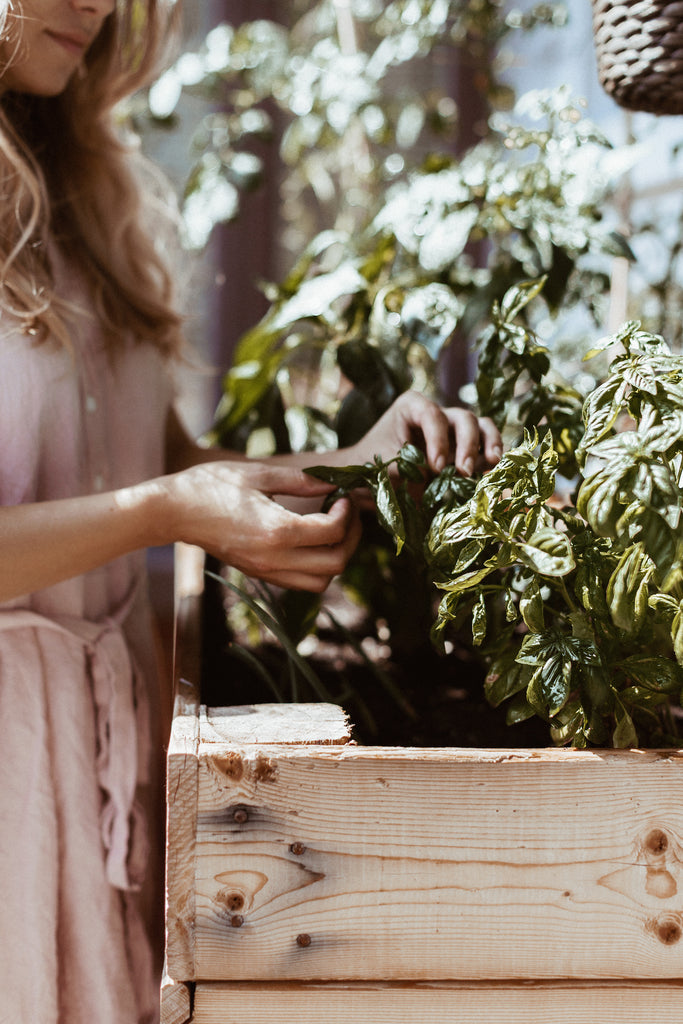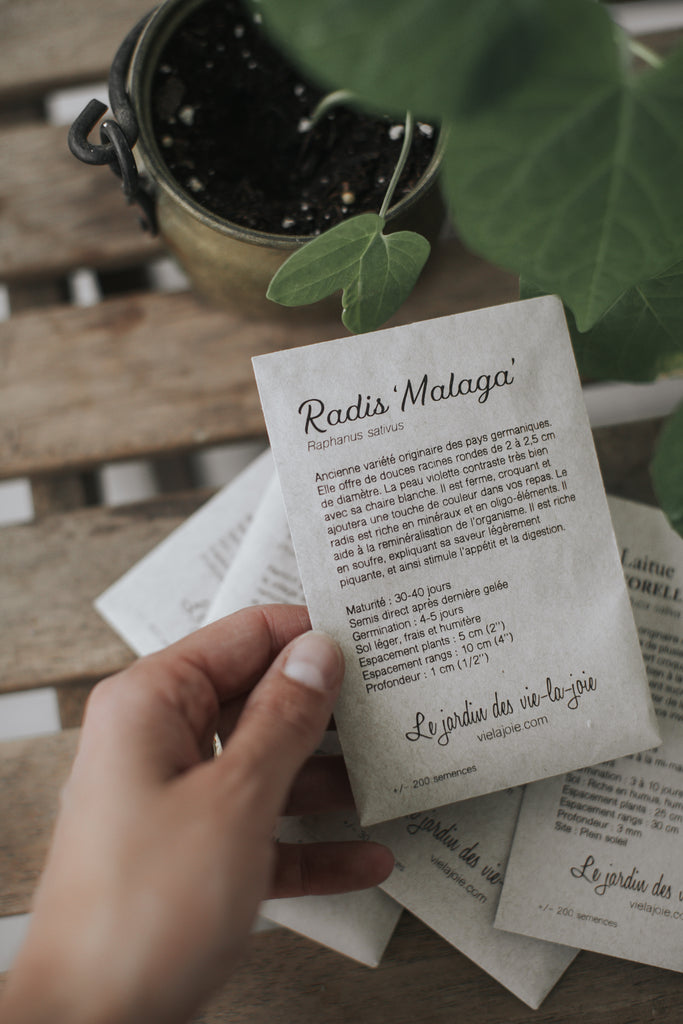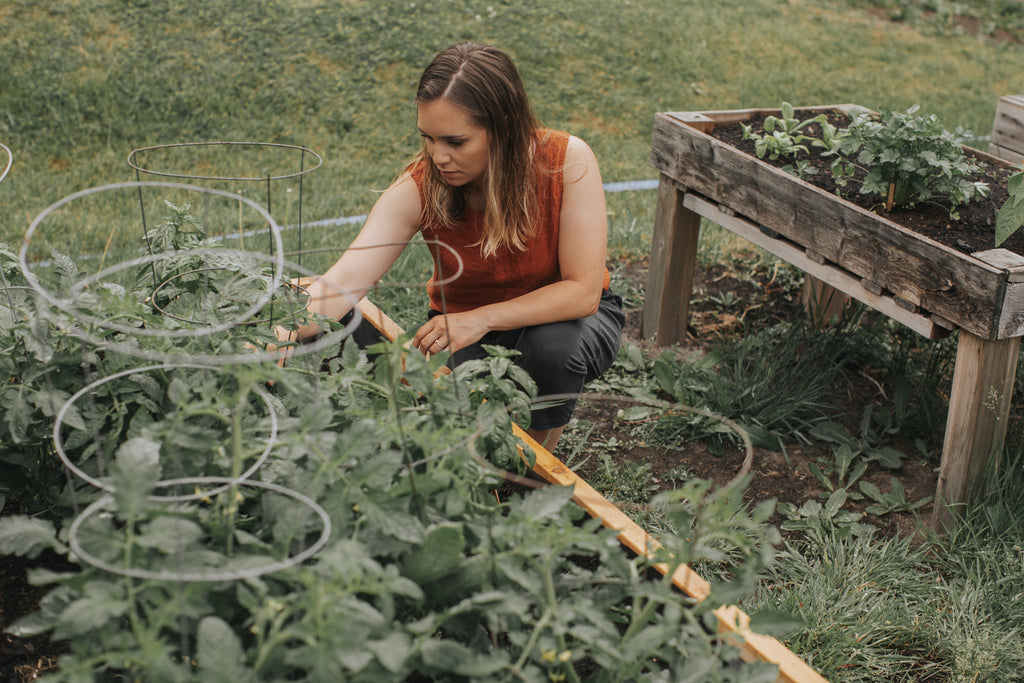Making a garden at home is a summer pleasure, one that I look forward to all winter! That time of the year when I can start planting my seedlings is something I love doing. Plus, if you have read our blog on how to become self-sufficient, you will remember that I am thriving to get my garden to grow larger this summer so I can get more from it to get some extra fresh and extra local veggies year-round. From your garden to your plate, you can't get much more eco-friendly than that!


I am no expert, like most, I’m still learning through my mistakes. There is so much to learn in the art of gardening, but I love learning from the experts (this time it was Ariane from Le jardin des vie-la-joie) to get all the right information and guidance.
Here are a few questions you should ask yourself before starting your own garden at home:
Do you want a garden box or one directly in the soil?
Both are marvellous options to grow beautiful, delicious veggies during the summer! Of course, if you’re in a smaller place that doesn’t offer much backyard space, garden boxes (or Smarpots) is often very convenient. You can also start planting them a little earlier (if the weather permits) since the dirt will unthaw earlier than the ground. Although, since there is a little less space, it does require more planning. You can then truly respect the needs of each vegetable you’ll be growing, like root vegetables which need more growing space in the ground etc. It’s quite important to find the right information for each variety you want to grow.

When growing your garden in the ground, there’s the option to plant perennial vegetable plants such as garlic, onions, asparagus, potatoes, rhubarb, etc. You don’t necessarily need a massive garden to feed a medium-size family either. Rule of thumb is that 4.5m x 6m can feed a family of 4. You should make sure that it faces south for it to get 6h hours of sun daily. Unfortunately, when your garden is directly on the ground, it’s easily accessible to everybody who might be interested, including small animals such as squirrels, groundhogs, skunks, raccoons, Etc looking to fatten up their stashes. You could add some wire mesh around the garden or use some natural repellents such as dog hair or cinnamon etc.
So whichever way you decide to go, odds are you will reap some lovely and delicious vegetables. I personally grow both at home to get the best of both worlds.
What dirt should be used?
Each plant has its different needs, but usually, if you go with some rich garden dirt which you can bonify with compost will generally work wonders. If you’re wondering about proportions between the garden dirt and the compost, it’s best to ask a specialist in a nursery or garden center; they have the best advice!
The same goes for fertilizers; each plant has its needs!
Here’s a little eco-friendly tip, keeps your eggshells to crush up and add to the dirt in your garden at the base of your tomato plants. It’s a beautiful fertilizer filled with calcium.
We keep the coffee grains to mix into the dirt as well. Jungle Fleur has a lovely recipe for a natural fertilizer on their blog about interior and exterior plants.
I’ve purchased my dirt from our local nursery, and they even delivered it directly at home with no bags at all. I also use liquid fertilizer made of seaweeds from Québec.
When should I sow?
There are three types of semis to plant inside very early in the spring (you can have a look at the calendar here as well as our blog on how to start your own semis here which you can then transplant into your garden later. Then there are the semis that should be planted directly in the garden because they cannot be transplanted. There is also a variety that can withstand both. Therefore the choice is ours!

Interior semis are ideal for plants who need a bit more maturity before being able to reap anything. Such as tomatoes, peppers, eggplants, cabbage, onions, leeks etc. We start them inside, usually mid-march, until the beginning of April. You must make sure they get enough water, warmth and sunshine. They also must be adequately acclimated to the outside temperature before being transplanted, and nightly temperatures should no longer go below 10 degrees for optimal transplant and plant growth.
Outside semis can be planted around mid-May when days grow warmer, and there are lower overnight freezing risks. Make sure they get all the water needed after transplanting them.
Of course, you can always also simply purchase grown plants that you plant in your garden once they are safely grown. Make sure you are buying ancestral varieties that are well adapted to our climate.
You can also purchase online local or ancestral seeds or at your local market.
You could even try to take seeds from your favourite vegetables and try to grow them. It’s an experience that costs nothing!
Always keep you’re the core of your lettuces, celery and leeks to make them grow all over again! It’s easy and fun to do at home. Learn more here
What to sow?
Go with what you and your family like the most, make sure it is all food that everybody enjoys! You can then save some money and also waste less. No need to go overboard with the seeds you plant. Lettuce plants need space between them to grow better, and the risk of losing it once it is fresh is lower when you plant a little less of it.
I personally always purchase bell peppers, zucchinis, cucumbers, carrots, blueberries, raspberries, salad, herbs and kale at the market, so this is what I planted in my garden to have some at home all summer. I also planted some flowers such as marigolds, calendula and lavender, whom are essential pollinators.
I will also be canning my tomatoes at the end of summer, so I planted a few tomato and basil plants!
The most accessible varieties of vegetables to plant and grow are lettuce, carrots, kale, tomato, herbs, onions, cucumbers, zucchinis, radishes, and peas. There are many options available to grow, but it does depend on your gardening capabilities!
When it comes to fruits, the best bet would be raspberries, they usually grow easily and offer a large reaping.
If you like making your own cosmetics, you could always also grow medicinal plants, such as plantain, calendula, chamomile, echinacea, and knapweed. We love reading up on all of these on the blog from Les Trappeuses, which also has many recipes to make at home.

Watering
Make sure you water abundantly after sowing or transplanting your plants, then water deep into the ground when dry and dusty, as well as when the heat waves come. Make sure the water pressure isn’t too hard to keep the roots and plants safe and robust.
Ideally, you can water your plants in the morning for the leaves to have time to dry, thus avoiding any risk of mushrooms forming. The most important rule is to never water when the sun is shining high. The risk of burning the leaves is very, and the water will simply evaporate.
I put a rain barrel in place at home to reduce my water consumption; it is truly the best to water the plants and flowers.
Spreading mulch around the plants will also help keep in the humidity, thus reducing the need to water a lot.
My son loves helping me out with the plants and watching the small sprouts blooming. I believe it’s such a great way to teach them the importance of biodiversity, having them see the evolution of a seed that was planted transform into a flower, which then turns into a fruit or a vegetable is magical. It’s also a fun way to get them to appreciate the food presented to them in a meal when they know where and how it was grown ;).
Making your garden can probably seem intimidating, but there truly is nothing more gratifying than reaping your fresh vegetables!
Don’t be discouraged by a few hits and misses at first, read up on the subject, listen to podcasts, and don’t be shy about asking questions around!
Happy gardening to you all.
Sources:
https://jardinierparesseux.com/
https://www.amazon.ca/Nouveau-guide-illustr%C3%A9-jardinage-Canada/dp/0888506821

